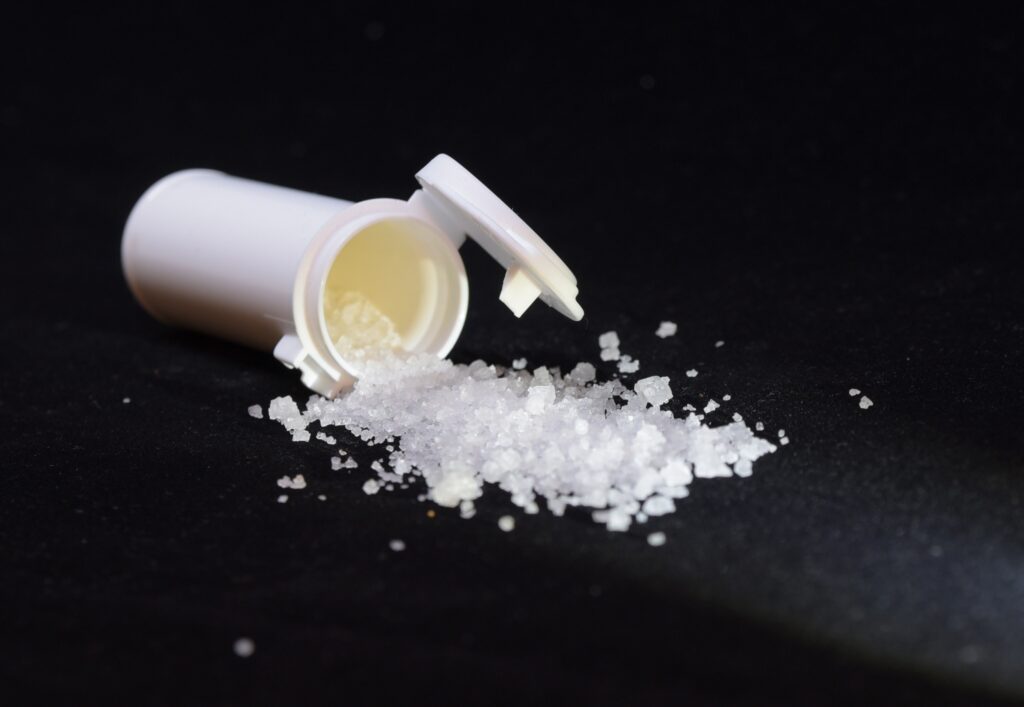From crystal shards to powders and pills, meth takes on different looks. By familiarizing ourselves with these forms, we can better protect ourselves and our loved ones from this highly addictive drug.
Get help with meth addiction today. Call us at 888.903.9898.
What Is Meth?
Methamphetamine, commonly known as meth, is a potent stimulant that affects the central nervous system. As soon as the drug enters the body, it triggers a massive release of dopamine, a feel-good neurotransmitter. This intense high can potentially lead to addiction from the very first use.
Recognizing its potential for dependence and addiction, the Drug Enforcement Administration (DEA) categorizes meth as a Schedule II controlled substance. That status makes it mostly illegal, however, methamphetamine may be prescribed in certain medical contexts, such as treating attention deficit hyperactivity disorder (ADHD) or obesity.
What Does Meth Look Like?
Meth can take various forms based on the manufacturing process and the additives used during production.
Crystal meth
If you’ve ever seen meth on a TV show or movie, there’s a good chance it was in crystal form. This type is typically clear, white, or bluish-white, though it may occasionally be yellow, brown, or pink, depending on the manufacturing process. Essentially, the clearer the meth, the purer the substance.
Crystal meth’s appearance is characterized by its shimmering, crystalline structure that resembles small, glassy rocks. This distinctive look has led to street names like “crystal,” “ice,” or “glass.”
Users often smoke or inject crystal meth, which is known for delivering an intense high. The effects of crystal meth are typically more powerful and longer-lasting compared to its powdered counterpart.
Powder
Powder meth is the second most common form of methamphetamine after crystal meth. It has a fine, powdery consistency reminiscent of flour or chalk dust. While typically white or off-white, the color can vary based on production methods and materials used.
For instance, using red pseudoephedrine tablets in manufacturing can result in pink or reddish powder. Certain solvents like camping stove fuel may give a bluish tinge, while meth made with gun scrubber often appears green. Yellow and light brown variations are also possible
Versatility is another defining feature of this form. Users may snort it, swallow it, or inject it after dissolving the powder in liquid.
Pill
In its legal form, methamphetamine is available as a prescription pill under the brand name Desoxyn (methamphetamine hydrochloride). This medication is used to treat attention-deficit hyperactivity disorder (ADHD) and obesity, typically as a last resort when other treatments prove ineffective.
Illicitly, methamphetamine pills are known as “yaba.” These tablets contain a mixture of caffeine and approximately 30% methamphetamine. They’re usually green or reddish-orange, smaller than aspirin, and stamped with logos, commonly the letters R or WY.
While yaba is most prevalent in Southeast Asia, it can also be found in the United States, particularly in rave and club scenes. Users typically swallow the pills, but some crush and snort them for faster effects. Alternative methods include melting the tablets to inhale the vapors or mixing them with solvents for intravenous injection.
Base
Base is a less common variant of meth and is distinguished by its waxy, oily, or paste-like consistency. This form is more concentrated than powdered meth and ranges in color from white to brown. Users typically smoke or inject it.
Liquid
While uncommon in street-level sales, traffickers often smuggle methamphetamine in liquid form. The drug is dissolved in water, creating a transportable liquid. Upon reaching its destination, the liquid is boiled to evaporate the water, leaving behind powdered meth for distribution or consumption
In its liquid state, methamphetamine has a syrupy consistency and typically appears dark yellow in color.
How Is Meth Addiction Treated?
Meth is one of the most addictive drugs, regardless of its form. However, it is possible to treat meth addiction. Some of the most common treatment options include:
Detoxification: This is the first step in meth addiction treatment. Rest, hydration, and restoring essential nutrients are the goals at this stage. Unfortunately, there are no FDA-approved medications for meth detox, however, some can alleviate withdrawal symptoms. Given how uncomfortable and potentially dangerous a meth detox can be, medical supervision is recommended.
Residential rehab: After finishing the detox phase, patients often spend 30 to 90 days in residential treatment. This level of care includes round-the-clock monitoring and a structured environment.
Behavioral therapy: Patients participate in behavioral therapy during residential treatment and often continue after discharge. The goal is to help people understand the roots of their addiction and equip them with the skills to manage cravings and triggers, ensuring they remain sober after treatment.
Medications: Studies are ongoing, but initial results indicate that the combination of injectable naltrexone and oral bupropion is effective in treating moderate or severe methamphetamine use disorder. More specifically, the medications help reduce cravings and improve self-reported quality of life.
These are just a few of the available meth treatment options. Additional support programs, such as Narcotics Anonymous (NA) and contingency management — where individuals receive cash rewards for maintaining sobriety — have also proven effective in helping people overcome addiction.
Meth Treatment at La Fuente Hollywood
LGBTQ individuals are disproportionately affected by drug use, including methamphetamine. Meth use has steadily risen in our community since the late 1990s, particularly among men who have sex with men.
Recognizing the high rates of meth use and addiction within our community, La Fuente dedicates extensive resources to offering LGBTQ-focused meth detox and treatment at our Los Angeles facility.
We provide on-site detox services and a range of long-term treatment options, including residential care, partial hospitalization programs (PHP), and intensive outpatient programs (IOP).
After treatment, we offer comfortable sober living facilities and an active alumni network to support our patients throughout the recovery process.
Learn more about our meth treatment programs. Call us at 888.903.9898.




